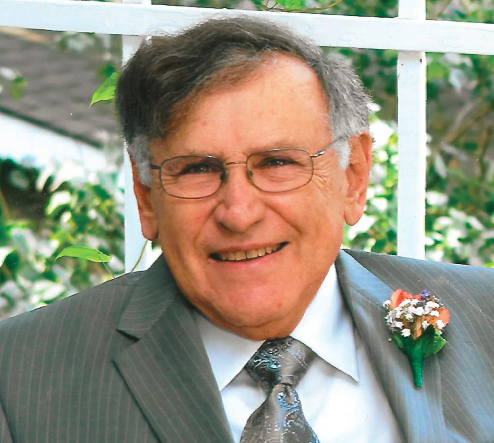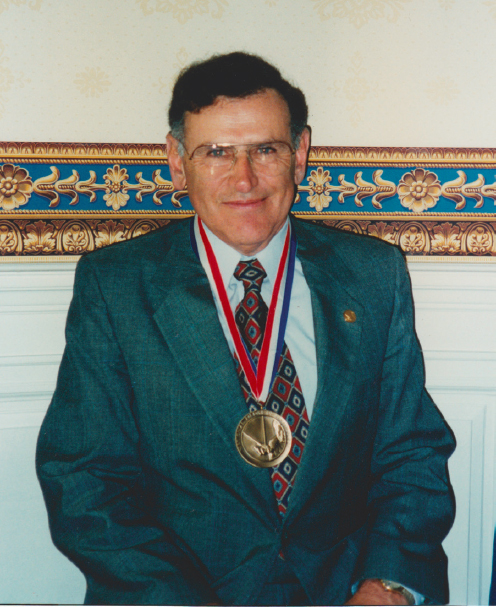RICHARD J. GAMBINO
1935–2014
Elected in 2004
“For the discovery of magnetic anisotropy, the enabling technology of magneto-optical recording.”
BY SANJAY SAMPATH AND HERBERT HERMAN
SUBMITTED BY THE NAE HOME SECRETARY
RICHARD JOSEPH GAMBINO was born May 17, 1935, and passed away August 3, 2014, at the age of 79. He was a beloved professor and revered advisor of students, a highly respected researcher and scientist, and a warm and devoted family man. His valued presence and contributions to Stony Brook University’s Materials Science and Engineering Department, and in particular the Center for Thermal Spray Research, are integral to the university’s history and standing. He was also instrumental in establishing the New York State Center for Advanced Technology on Sensors and setting up a comprehensive magnetics measurement facility while at Stony Brook.
Dick received a BA degree in chemistry from the University of Connecticut in 1957 and MS degree in inorganic chemistry from the Polytechnic Institute of New York in 1976. He worked at the US Army Signal Research and Development Laboratory in Fort Monmouth, New Jersey (1956–60) and at Pratt & Whitney Aircraft Division, United Aircraft Corporation, in Middletown, CT (1960–61) before joining the IBM Thomas J. Watson Research Center (Yorktown Heights, NY) in 1961.
__________________
Adapted with permission from IEEE Transactions on Magnetics 51(2). © 2015 IEEE.
During his 3-decade career at IBM, he rose to become manager of amorphous magnetism. His main research interests while there were in crystal growth, magnetic and superconducting properties of alloys and intermetallic compounds, sputtering, galvanomagnetic and magneto-optic effects, amorphous magnetic films, quasicrystals, and high-temperature oxide superconductors.
In 1993 he made a career shift and accepted a position as research professor of materials science at Stony Brook, supported by the IBM Technical Academic Career Program, which is designed to assist outstanding IBM employees’ transition to university teaching and research. At Stony Brook he did research on materials for electronics and for magnetic, temperature, and strain sensors, initiated research programs, established a facility, and developed collaborations. He taught both graduate and undergraduate students, served as major advisor to 16 PhD and 9 MS graduates of the Materials Science and Engineering Department, and was still working with grad students until the time of his death.
In 1996 the Stony Brook Center for Thermal Spray Research was established through the National Science Foundation Materials Research Science and Engineering Center (MRSEC). Dick joined the university’s center in 1998 to enable the expansion of thermal spray applications to functional materials (e.g., magnetic materials, sensors) and introduce sensor applications for direct write thermal spray. This effort ballooned to a multimillion-dollar initiative resulting in multiple patents and publications.
In 1999 he became part of the Defense Advanced Research Projects Agency’s Mesoscale Integrated Conformal Electronics (MICE) program in the MRSEC. The MICE project introduced thermal spray into the arena of electronic circuits and sensors and led to the formation in 2002 of MesoScribe Technologies, which Dick cofounded (with SS, Robert Greenlaw, and Jon Longtin) and led as president and chief technical officer. Under Dick’s scientific leadership, the company enabled commercialization of direct write thermal spray sensors, which continue to impact critical applications such as embedded
sensors for harsh environment applications, flexible electronics, and printed antennas on complex geometries. The technology received an R&D 100 Award in 2007.
Dick was awarded 45 patents, authored 160 publications, and, with Takao Suzuki, edited Magneto-Optical Recording Materials (IEEE Press, 2000).
His contributions throughout his career were recognized with a number of awards and honors. In 1992 he and IBM colleagues Praveen Chaudhari (NAE 1988, NAS 2003) and Jerome J. Cuomo (NAE 1993) received the IEEE Morris N. Liebmann Memorial Award for their discovery of amorphous magnetic films used in magneto-optic data storage systems. In 1995 they were honored by President Bill Clinton as recipients of the National Medal of Technology and Innovation “For the discovery and development of a new class of materials—the amorphous magnetic materials—that are the basis of erasable, read-write, optical storage technology, now the foundation of the worldwide magnetic-optic disk industry.”
In addition, Dick was elected a fellow of the IEEE (1995) and member of the National Academy of Engineering (2004), and in 2007 he was inducted into the Long Island Technology Hall of Fame. He received the State University of New York Medallion of Distinction and, after his official retirement, was awarded an honorary doctorate from Stony Brook in 2013.
To quote Jerry Cuomo, “Dick’s work in material science has been so prolific that to view its depth and scope from the perspective of any one person would not do justice to its multifaceted content, which included notable contributions in magnetism, synthesis, processing, and applications, and involved collaborations with many prominent US and international scientists. Although he achieved outstanding recognition for his work in amorphous magnetic materials with uniaxial magnetic anisotropy, the entire compendium of his work was fundamentally and technologically significant.”
Beyond his avid technical engagement, Dick had a passion for sailing, painting, reading, history, and, especially, family. He married his high school sweetheart, Patricia Podmore, and they raised four children: Jeffrey, Janice (1958–2011), Pamela,
and Donna. Dick and Patricia spent 45 happy years together until her passing in 2004. In 2009 he married Pamela F. Carr and gained “bonus children” (as he called them) Lisanne, Michelle, and Daniel. His daughter Donna said he was “doubly blessed to find true love once again.” He is survived by Pamela and their blended family, including eight grandchildren.
Dick was a gifted and natural teacher. Whether it was science, sailing, or painting, he loved to share these gifts with all around him. His kindness, humility, warmth, inspiration, and enthusiasm for life were contagious, and he is greatly missed by all whose lives he touched.








